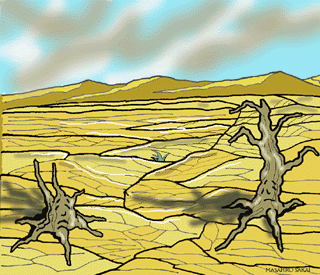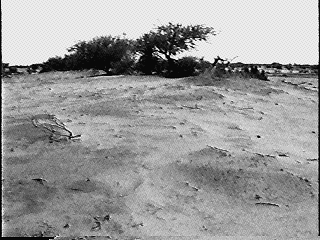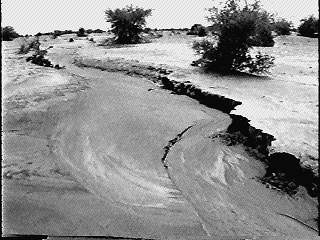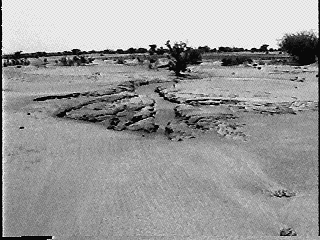

Discussed at length during the 1992 United Nations Conference on Environment and Development, and driven by the renewed interest of the United Nations Environment Program (UNEP, 1992), desertification has reemerged
on the international agenda as a topic of concern. Whether or not the deserts are growing, their population surely is; for example, drylands in the Middle East cover 99 percent of the surface area, and the region's rate of population growth is approximately 3 percent per year. Many millions of people have nowhere else to go since half the countries on earth lie partly or entirely in arid and semiarid zones, which cover one-third of the planet's land surface, 44 percent if the subhumid zone is included.
In 1950, the population of these countries was 76 million; in 1985, it reached 205 million; and the forecast for 2000 is 300 million (Braverman, 1994).
While overall population densities in most of the world's drylands are low overall, locally this may not be the case. For example, I estimate local population densities in the agricultural lands of the Niger-Nigeria border region to reach 148/sq. km. (Milich and Weiss, 1997). In some such densely-populated areas, demands on natural resources - arable land, grasslands for grazing, trees for fuelwood and browsing - are unsustainable given the indigenous systems in use at present. "The ballooning demand for resources that this growth represents almost inevitably generates extensive resource abuse in the short run," according to a World Bank study, which goes on to say, "Adjustments are not made quickly enough to these changing conditions: consumption accelerates, but at the cost of overexploitation or 'mining' of the resource base rather than investment in its improvement or even sustenance. The desertification process takes hold" (Gorse and Steeds, 1987).
This same World Bank report defined 'desertification' as "a process of sustained decline of the biological productivity of arid and semiarid land; the end-result is desert, or skeletal soil that is irrecuperable.... Biological productivity refers to the
naturally-occurring plant and animal life as well as to the agricultural productivity of a given area. Common indicators of desertification include a reduction in the amount and diversity of plant and animal species, loss of water-retention capacity, lessened soil fertility, and increasing wind and water erosion. Eventually, plant and animal communities become so radically simplified that species formerly common in the area can no longer survive under the drastically altered circumstances, even if they
are deliberately reintroduced."
A substantial number of scholars took issue with colleagues advocating this perspective, basing their criticism on the alarmist tone - 'irrecuperable' being the paradigm most under attack. Forced by this academic debate to seek a more-benign, universally
-acceptable definition, the 1992 U.N. Conference on Environment and Development (the "Rio conference") declared that, "Desertification is land degradation in arid, semiarid and dry subhumid areas resulting from various factors, including climatic variations and human activities." But this tactic has scarcely laid the issue to rest, and dissent as to whether desertification indeed exists continues. A 1990 expert meeting on desertification held in Örenäs, Sweden, contributed the following: "There is inadequate public and political understanding of the concepts and extent of desertification, and frequent statements on rapid and large-scale desert encroachment cannot be substantiated. Desertification is a dynamic process, drylands are resilient, and desertification status may change over periods of a few years (e.g., a decade)." The meeting suggested a new definition of desertification be adopted: "Desertification, or serious dryland degradation, is the spread of desert-like conditions of low biological productivity due to human impact under climatic variations" (Helldén, 1991).
The basic arguments, pro or con desertification, condense to these: Are desert lands resilient or fragile? Are changes natural (climate-induced) or anthropogenic? Are changes reversible? How much land degradation is necessary before we declare desertification to have taken place? Does anthropogenic land degradation induce or augment meteorological drought?
Whether we use the term 'land degradation' or 'desertification' is a matter of little ultimate consequence; desertification is real - not in the sense of an inexorable advance of the Sahara southward (see this chart), but in the localized degradation of an ecosystem so that ecosystem function is impaired, and the ecosystem's carrying-capacity for humans reduced. It is this latter of these two adverse impacts that has most direct meaning at
the local level, particularly in light of population growth and therefore additional burdens and expectations on ecosystems. Thus, the issues distill down to considerations of sustainability).
Henri Le Houérou (a French scientist with considerable working experience in arid West Africa who is currently at the Centre National de la Recherche Scientifique), has recently reworked his definition of 'desertization' to state that it is "... the irreversible growth of new desert landscapes in arid regions which, not long before, presented no such features. It is characterized by a considerable reduction in perennial vegetation and its concentration along the hydrological network, with the development of dune systems and desert pavements or 'regs).' In general, perennial plant cover is less than 5 percent, and often nonexistent" (Le Houérou, 1992).
Accepting, therefore, that desertification implies localized, severe land degradation impairing ecosystem function, characterized by the growth of new, desert-like landscapes, consider the following video-capture images. I took these in an agropastoral area (coordinates 6.31 E, 13.71 N) in Hausaland, close to the Niger-Nigeria border in Sahelian West Africa. These are images of a landscape that cannot be described in a manner other than by using the term "desertified," especially when comparing this are
a to the productive fields in the vicinity. The only soil left on the surface is in isolated pockets around the few remaining trees. Because it had rained during the previous night, I was able to witness hydraulic erosion in progress, and the water runnels and gullies seen in the images are evidence of this process. An old man from a village 500 meters west of these coordinates exclaimed, as he swept his arm around, that 18 years ago all the area used to be fields (including his fields). A strong wind
came out of the east 9 years ago (1986), and blew away most of the sandy soil.
 |
 |
 |
 |
 |
 |
Gorse, J.E. and D.R. Steeds, 1987. Desertification in the Sahelian and Sudanian zones of West Africa. Washington, D.C.: World Bank Technical Paper no. 61.
Helldén, U., 1991. Desertification-time for an assessment? Ambio 20:8, 372-383.
Le Houérou, H.N., 1992. Climatic change and desertization. Impact of Science on Society 42:2, 183-201.
Milich, L. and E. Weiss, 1997. Characterization of the Sahel: Implications of correctly calculating interannual Coefficients of Variation (CoVs) from GAC NDVI values. International Journal of Remote Sensing 18:18, 3749-3759.
UNEP, 1992. World Atlas of Desertification. Edward Arnold Publishers, London, U.K., 69 pp.
The Table of Contents of my work on desertification and food security is available.
 Back
Back  Onward!
Onward!
This site last updated November 11, 1998.